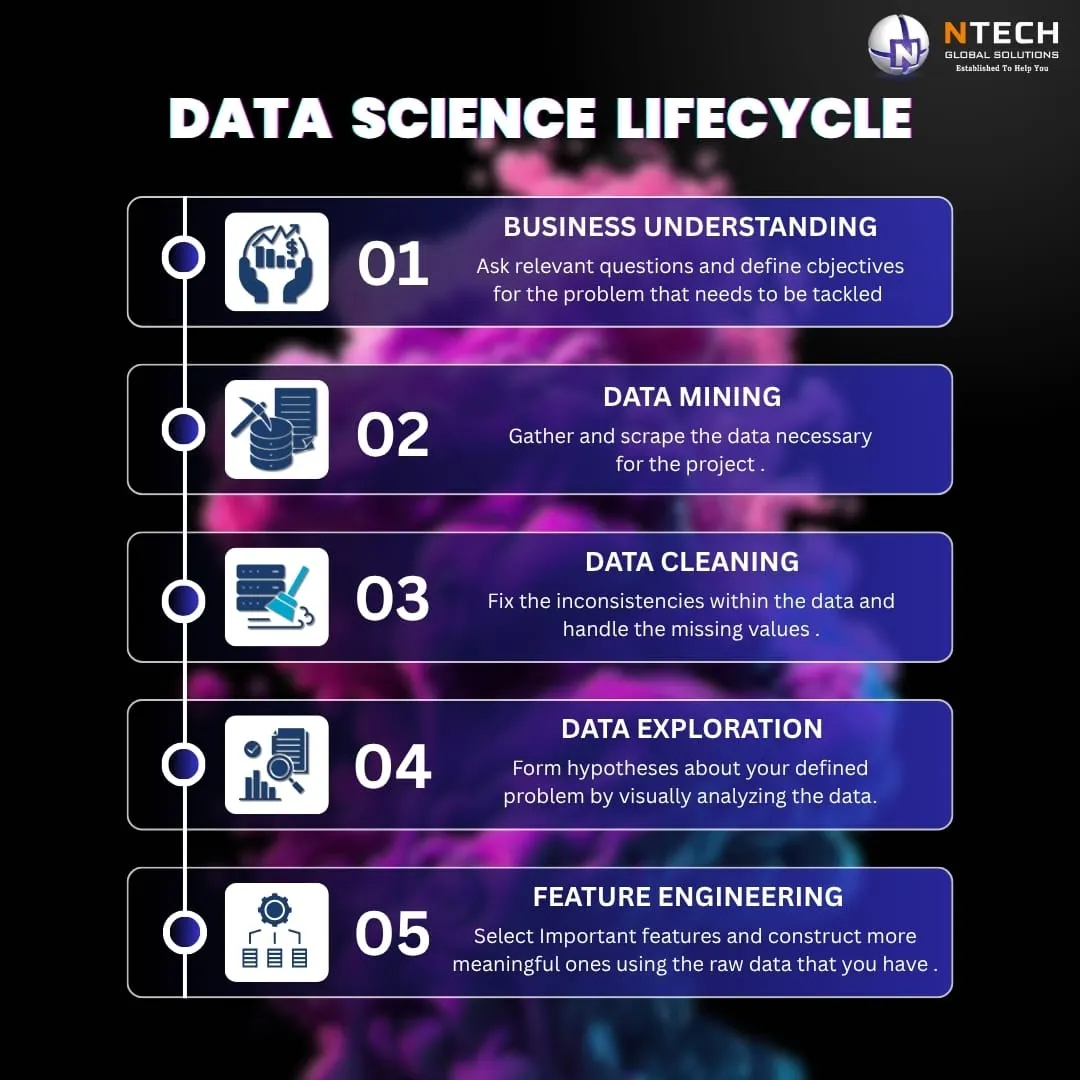In today’s fast-moving digital world, data isn’t just numbers — it’s currency. And the people who know how to work with it? They’re shaping the future.
Whether you’re managing a business, running marketing campaigns, or building apps, understanding the data science lifecycle in 2025 is no longer optional. It’s the framework that turns raw data into real results.
Let’s break down the five core steps of data science and explore how they work together to power smart, data-driven strategies.
🔍 Step 1: Business Understanding — Defining the Real Problem
Everything begins with a question. In data science, the first step is to understand the business problem you’re trying to solve.
Are customers dropping off after signup?
Is a product underperforming in a specific market?
Before any data is touched, clear objectives must be defined. This step helps teams focus on what matters most and aligns analytics efforts with real business outcomes.
Why it matters in 2025: Companies that prioritize business data insights from the start save time and money — and build more relevant solutions.
🧲 Step 2: Data Mining — Gathering What You Need
With a clear objective in mind, the next step is data mining — the process of collecting the right data from the right sources.
That could mean pulling records from internal databases, scraping data from websites, or connecting to external APIs. In modern data analytics, the variety and volume of data sources has exploded, making this step both powerful and challenging.
The key is knowing what to collect — and what to leave out.
🧽 Step 3: Data Cleaning — Preparing Your Data for Analysis
Ask any experienced data scientist and they’ll tell you: clean data is gold.
This step, also known as data preparation, involves fixing missing values, removing duplicates, and correcting inconsistencies. It’s all about ensuring the data is high-quality and ready for analysis.
If your data is messy, your results will be too — no matter how fancy the model.
Clean data importance has skyrocketed in 2025, especially with the rise of automation and real-time insights.
📊 Step 4: Data Exploration — Let the Patterns Speak
Once your data is clean, it’s time to explore.
Data exploration is like turning on the lights — you suddenly see the story the data is telling.
This stage involves using visualizations and statistical summaries to understand what’s going on inside your dataset. You might discover trends, detect outliers, or uncover correlations that weren’t obvious before.
Data exploration is like turning on the lights — you suddenly see the story the data is telling.
It’s a crucial part of modern analytics and sets the foundation for better decision-making.
⚙️ Step 5: Feature Engineering — Building Smarter Data
Not all data is immediately useful. That’s where feature engineering comes in.
This is the process of transforming raw data into more meaningful inputs for machine learning models. You might combine variables, categorize data, or create entirely new features that better represent the problem.
Think of it like refining raw materials into a polished product — this is where data becomes intelligent.
In 2025, feature engineering is a critical skill, especially for improving model accuracy and performance.
🚀 Why This Lifecycle Matters More Than Ever
The steps of data science aren’t just a checklist — they’re a roadmap. They ensure that companies, regardless of industry, can turn data into action.
With businesses relying more than ever on data-driven strategy, knowing how this lifecycle works empowers teams to stay competitive, innovative, and efficient.
Final Thoughts
The data science lifecycle in 2025 is more relevant than ever. It blends technology with critical thinking, automation with human insight. Whether you’re a beginner learning the ropes or a business leader exploring analytics, understanding these five steps is the key to unlocking smarter decisions.
So, the next time you hear the term “data science,” just remember — it’s not magic. It’s a process. And now you know exactly how it works.
So, now that you’ve got a clear idea of how the data science lifecycle works and why it matters, the real question is — are you ready to actually do it?
Because here’s the truth: reading articles is great, but real transformation happens when you start building. And that’s exactly what we help you do at Ntech Global Solutions.
We don’t believe in just teaching definitions or tools. We focus on helping you think like a data scientist, solve real problems, and build the kind of portfolio that makes recruiters take notice. From the first step of understanding business needs to cleaning data, analyzing it, and building predictive models — we walk you through it all, side by side.
Our approach is practical, personal, and built for today’s fast-changing industry. You’ll get hands-on with real-world datasets, work on live projects, and gain the confidence to step into the field with clarity — not confusion.
Whether you’re a college student curious about tech, a working professional ready to upgrade, or someone looking to switch into a high-growth career path, we’ve got your back. And we don’t stop at training — we also offer career support and mentorship that actually makes a difference.
Because your future in data science isn’t just waiting — it’s being built. One decision at a time. Let’s make it count.


Comments
No Comments Yet
Leave a Reply